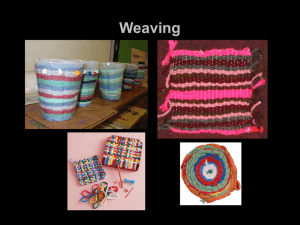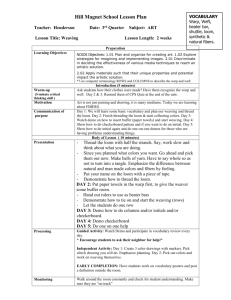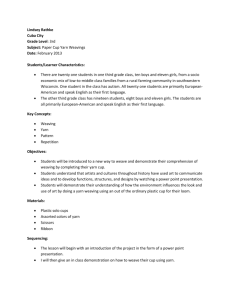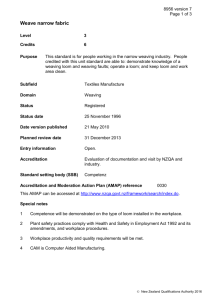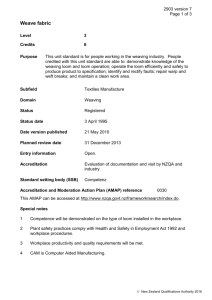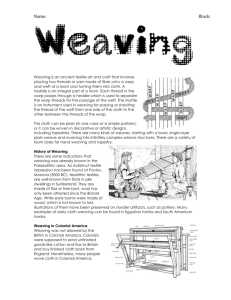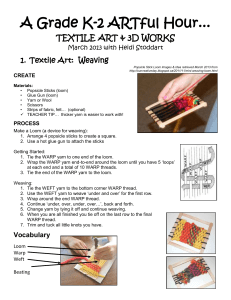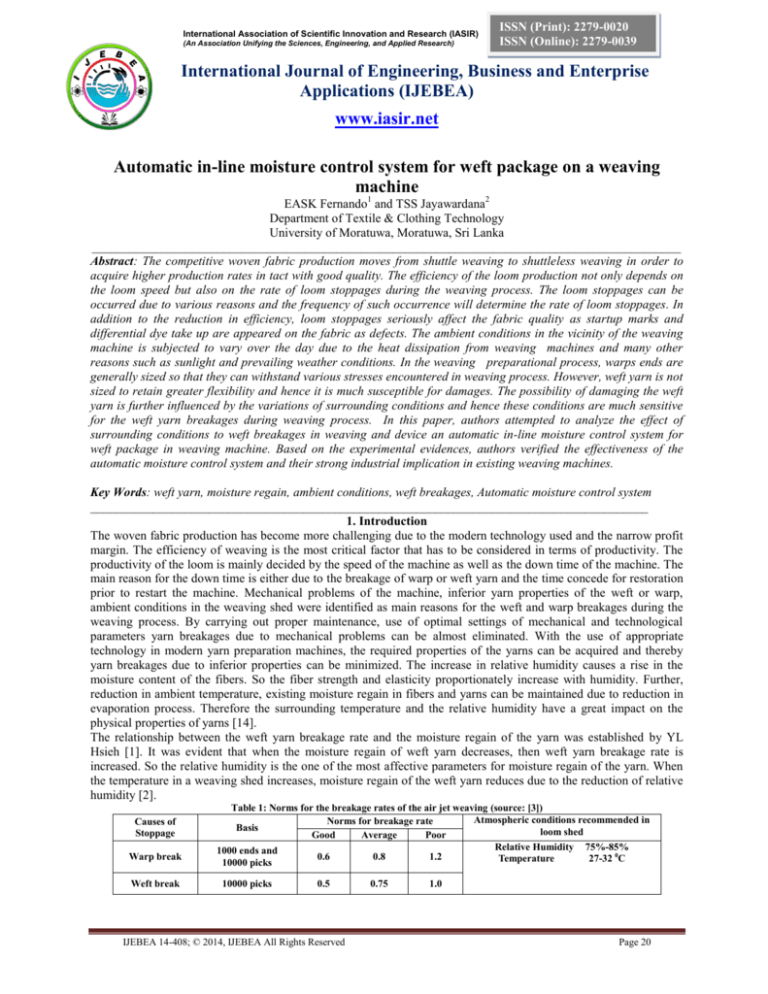
International Association of Scientific Innovation and Research (IASIR)
(An Association Unifying the Sciences, Engineering, and Applied Research)
ISSN (Print): 2279-0020
ISSN (Online): 2279-0039
International Journal of Engineering, Business and Enterprise
Applications (IJEBEA)
www.iasir.net
Automatic in-line moisture control system for weft package on a weaving
machine
EASK Fernando1 and TSS Jayawardana2
Department of Textile & Clothing Technology
University of Moratuwa, Moratuwa, Sri Lanka
______________________________________________________________________________________________
Abstract: The competitive woven fabric production moves from shuttle weaving to shuttleless weaving in order to
acquire higher production rates in tact with good quality. The efficiency of the loom production not only depends on
the loom speed but also on the rate of loom stoppages during the weaving process. The loom stoppages can be
occurred due to various reasons and the frequency of such occurrence will determine the rate of loom stoppages. In
addition to the reduction in efficiency, loom stoppages seriously affect the fabric quality as startup marks and
differential dye take up are appeared on the fabric as defects. The ambient conditions in the vicinity of the weaving
machine is subjected to vary over the day due to the heat dissipation from weaving machines and many other
reasons such as sunlight and prevailing weather conditions. In the weaving preparational process, warps ends are
generally sized so that they can withstand various stresses encountered in weaving process. However, weft yarn is not
sized to retain greater flexibility and hence it is much susceptible for damages. The possibility of damaging the weft
yarn is further influenced by the variations of surrounding conditions and hence these conditions are much sensitive
for the weft yarn breakages during weaving process. In this paper, authors attempted to analyze the effect of
surrounding conditions to weft breakages in weaving and device an automatic in-line moisture control system for
weft package in weaving machine. Based on the experimental evidences, authors verified the effectiveness of the
automatic moisture control system and their strong industrial implication in existing weaving machines.
Key Words: weft yarn, moisture regain, ambient conditions, weft breakages, Automatic moisture control system
_________________________________________________________________________________________
1. Introduction
The woven fabric production has become more challenging due to the modern technology used and the narrow profit
margin. The efficiency of weaving is the most critical factor that has to be considered in terms of productivity. The
productivity of the loom is mainly decided by the speed of the machine as well as the down time of the machine. The
main reason for the down time is either due to the breakage of warp or weft yarn and the time concede for restoration
prior to restart the machine. Mechanical problems of the machine, inferior yarn properties of the weft or warp,
ambient conditions in the weaving shed were identified as main reasons for the weft and warp breakages during the
weaving process. By carrying out proper maintenance, use of optimal settings of mechanical and technological
parameters yarn breakages due to mechanical problems can be almost eliminated. With the use of appropriate
technology in modern yarn preparation machines, the required properties of the yarns can be acquired and thereby
yarn breakages due to inferior properties can be minimized. The increase in relative humidity causes a rise in the
moisture content of the fibers. So the fiber strength and elasticity proportionately increase with humidity. Further,
reduction in ambient temperature, existing moisture regain in fibers and yarns can be maintained due to reduction in
evaporation process. Therefore the surrounding temperature and the relative humidity have a great impact on the
physical properties of yarns [14].
The relationship between the weft yarn breakage rate and the moisture regain of the yarn was established by YL
Hsieh [1]. It was evident that when the moisture regain of weft yarn decreases, then weft yarn breakage rate is
increased. So the relative humidity is the one of the most affective parameters for moisture regain of the yarn. When
the temperature in a weaving shed increases, moisture regain of the weft yarn reduces due to the reduction of relative
humidity [2].
Causes of
Stoppage
Warp break
Weft break
Table 1: Norms for the breakage rates of the air jet weaving (source: [3])
Atmospheric conditions recommended in
Norms for breakage rate
Basis
loom shed
Good
Average
Poor
Relative
Humidity
75%-85%
1000 ends and
0.6
0.8
1.2
Temperature
27-32 0C
10000 picks
10000 picks
0.5
IJEBEA 14-408; © 2014, IJEBEA All Rights Reserved
0.75
1.0
Page 20
EASK Fernando et al., International Journal of Engineering, Business and Enterprise Applications, 10(1), September-November, 2014, pp. 20-27
Inadequate moisture regain of a weft yarn reduces its strength, flexibility while hairiness is increased. Quality of the
woven fabric can also be increased by the reduction of the hairiness, and the elimination of static electricity etc.
These can be achieved through regulation of proper moisture level in the yarn and it is a mandatory requirement as
per the findings of Talukdar et. al. [3].
When considering the production efficiency of a weaving mill, possible rate of breakage due to above mentioned
reasons are defined. In a standard weaving mill, the rate of breakage should be kept below the maximum acceptable
standard unless corrective actions are to be taken [3].
The higher the moisture regain, the lower the insulation resistance and helps to carry off the electrostatic charge.
Hence relative humidity needs to be maintained above the lower limit of relative humidity range specified for various
textile processes to avoid the problems of yarn breakages. Under dry condition yarn becomes more brittle and
susceptible for damages as well as to increase the generation of static charge making the fiber more dusty and cause
to fiber fly.
Above the upper limit of relative humidity specified, fibers tend to stick and lead to formation of laps on the rolls
which disrupt the production process. For instance, relative humidity in a textile mill producing cotton fabrics is
required to be maintained at 80% to 85% in contrast to general relative humidity condition of a room is around 65%.
High humidity in a weaving shed also helps to increase the abrasion resistance of the warp [3]
In literature, the effect of temperature and humidity in a weaving shed on weavability was basically discussed and in
depth concern was given to warp breakages covering a wide range of fabrics [4]. However effect of temperature and
humidity on weft breakages was not adequately investigated and analyzed.
II. Problem and its significance
The production efficiency is basically depending on the weft and warp breakage rates and the time taken to restore
and restart the loom. In addition to the mechanical problems of the loom, the warps and wefts can be broken due to
many reasons. However, the warp breakage could be made insignificant through a good sizing process due to which
physical and mechanical properties of the sized yarn is enhanced so that it could withstand various stresses imposed
on warp ends during fabric formation. Therefore productivity of a weaving machine significantly depends on weft
breakage rate because usually weft yarn is not sized. If the weft yarn were sized it becomes stiff and rigid, as a result,
the fabric formation process is impaired and required pick density and cover factor cannot be achieved. Therefore, it
is required to somehow strengthen the weft yarn intact with flexibility.
Due to higher weft breakage rate, frequent loom stoppages are experienced. Such stoppages and subsequent starts
lead to variation in tension of the warp sheet and also in the fabric is being woven. As a result fabric parameters such
as pick density and fabric cover factor are subjected to vary [12]. Intermittent variation in pick density of the fabric
lead to different dye take up in dyeing process and it appears as different shades in the fabric (Fig.1, Fig.2). This
fabric defect is called stripes [12,13].
Fig.1: loom bar or starting mark (thick or dense mark) (source [7])
Fig.2: Different dye take up (source: [7])
In order to enhance the running efficiency of a loom and to improve the quality of the fabric, the reduction of weft
breakage rate is vital. The quality of weft yarn and the surrounding conditions in the weaving shed are two major
reasons for the weft yarn breakages. However with well controlled sophisticated spinning and winding machines
could produce high quality weft yarn which can withstand high stresses in high speed weaving. Even in good quality
weft yarn, mechanical properties are degraded significantly due to improper surrounding conditions. For instance, the
temperature and the humidity level in the vicinity of the loom may not fall within the standard levels prescribed for
continuous running of a loom.
Outside temperature of the factory is significantly changed over the day as well as prevailing weather condition has a
great impact on the surrounding conditions in the weaving shed. Further, high speed weaving machines dissipate
considerable amount of heat as these machines are equipped with large motors, main nozzles, relay nozzles and
solenoid valves. Hence, it is practically impossible to maintain the desired humidity level and temperature in the
weaving shed. So moisture regain which is the percentage absolute moisture content to the dry weight of the yarn [13,
8] is the decisive parameter for weft breakages. Low humidity and high surrounding temperature dries out the weft
package on the weaving machine and moisture regain of the weft yarn does not provide conducive conditions for
weaving.
IJEBEA 14-408; © 2014, IJEBEA All Rights Reserved
Page 21
EASK Fernando et al., International Journal of Engineering, Business and Enterprise Applications, 10(1), September-November, 2014, pp. 20-27
In case of weft breakage, the broken weft yarn must be removed; weft insertion system should be reset and then
restarted the loom. The economics of weaving are critically affected by the number of breakages as the maximum
potential productivity of the loom cannot be met and much of the weaver’s time will be wasted in resetting and
restarting the loom. In order to curtail above stated problems, it is necessary to maintain the desired moisture regain
to achieve the required strength, flexibility of weft yarn suitable for high speed weaving as well as to reduce hairiness
of the weft yarn.
III Existing Methods to control moisture content of yarn in weaving
The moisture content of the warp and weft yarns are maintained at required level by direct spraying of water in the
vicinity of weft packages at the weaving machine, pre-conditioning of weft packages prior to weaving, conditioning
of the weaving shed, waxing of weft yarn during winding and water atomization coupled with air washer system [10].
The direct spraying of water is a manual ad hoc process where the success is mainly depends on the experience of the
weaver who sprays water. Excessive water may mal function the electrical and electronic devices as well as to
corrode the metal parts of the loom [4].
Preconditioning is achieved by keeping the weft packages in a room equipped with humidifiers. However, the weft
packages are placed on the looms due to higher temperature (around 350-370C) and low humidity (45%-50%)
moisture regain is significantly reduced impairing the physical properties of the weft yarn [5].
Heat generating looms and metal parts with higher absorbent capacity made conditioning of weaving sheds
economically infeasible. This situation is further engraved with large space inside the weaving shed to bring down the
noise levels to acceptable standards to prevent health hazards to the employees. This approach is completely against
the green concepts also due to high waste of energy.
Waxing of weft yarn during the winding process can retain the moisture contents in varying ambient conditions [4].
The natural wax covering fibers softens at the raised temperature conditions, thereby adversely affecting the
lubricating property of wax for controlling moisture content and static /dynamic friction. Due to loss of lubrication,
the fiber friction and rigidity of weft yarn are increased significantly.
Water atomization coupled with air washer system is a state of yarn technique [9] but yet suffers from many
disadvantages. It consumes a large amount of water for humidifying a large area where weft packages are located for
each weaving machine and a significant waste of water is inevitable. This system is also not in line with the green
concepts practices due to waste in water and not optimal in terms of energy.
IV. Methodology
Initially, the relative humidity variation inside the weaving shed and ambient surrounding was studied during the day
time when the weaving mills are in operation. Further to humidity, temperature variation at the same places was
monitored. Subsequently, temperature and humidity profiles were developed to investigate the effect of humidity and
temperature on weavability. Further the quantitative effect of humidity on yarn properties at different temperatures
was analyzed under laboratory conditions.
The solution strategy for varying moisture regain of weft yarn with the change of the environmental conditions in the
weaving shed should be essentially economical. An automatic in-line moisture control system is designed to control
the moisture content of the weft package placed inside a chamber while the weft yarn is being fed to the weaving
machine. The weft yarn breakage rate was further investigated with and without the device developed to measure the
effect of humidity regulation quantitatively in weavability.
V. Prototype developed
The humidity control system comprising humidifying chamber in which weft package is placed, portable steel rack to
equip the humidifying chamber, temperature and humidity transducers to measure temperature and humidity
respectively inside the chamber, jet type atomizer driven by a high pressure compressor to spray atomized water
vapor into the chamber and 16F877A PIC microcontroller to control the humidity level directly and thereby the
temperature indirectly with the resident control software.
Humidifying chamber is composed of two truncated conical shape envelops with different angles, which are carefully
designed by considering the range of balloon diameter according to the maximum size of the weft package, connected
front-to front with a drain cock at the lowest point of the humidify chamber to drain out the accumulated water from
time to time. The empty weft package due to usage can be easily and conveniently replaced by the new package by
opening the flatter back part of the chamber. The picture of the humidifying chamber is given in Fig. 3. Antistatic
polycarbonate material can be used to develop humidifying chamber.
IJEBEA 14-408; © 2014, IJEBEA All Rights Reserved
Page 22
EASK Fernando et al., International Journal of Engineering, Business and Enterprise Applications, 10(1), September-November, 2014, pp. 20-27
Fig. 3: humidifying chamber
Viscosity of water, operating pressure of the reciprocating type compressor used and response time were technical
parameters which influence the selection the atomizing nozzle. Fogging and atomizing models can deliver a targeted
spray of ultra fine droplets and hence atomizing spray-vector type nozzle has been selected considering the size and
shape of the package, volume of the humidifying chamber and size of droplets in addition to above technical
parameters. Temperature sensor, response time, measurable temperature range, power consumption, calibration
facility, cost and size of the sensor were used as decisive criteria in selection of the temperature sensor LM 35. Since
it provides an analog output, it can be easily deployed in automatic temperature monitoring system as it can be
directly connected to PIC micro controller. In determination of RH sensor, response time, power consumption and
size of the sensor become key features. The selected sensor possessed near linear voltage output vs. percentage
relative humidity and chemical resistance as technological advantages.16F877A PIC microcontroller which has the
ability to accept analog signals due to inbuilt A/D convertor was selected as the controller to regulate humidity. It
also facilitates direct connection of temperature and humidity sensors. The rationale for the deployment of
programmable controller is to adapt the controller to different climatic changes. The resident control software written
in MikroC determines the precision of humidity regulation and the indirect control of temperature inside the chamber.
VI. Design of humidifying chamber
The humidifying chamber should have a special shape so that the condensed water accumulated inside it can be easily
discharged from the drain cock. So a conical shaped envelop (part B) is connected to the lower part of the truncated
conical envelop (part A) back to back to allow weft yarn to unwind freely from the weft package in the chamber
during fabric formation. The latter envelop of the chamber serves as balloon controlling device and its bottom
diameter is selected so it is just above the maximum. The diagrammatic view of the humidifying chamber is given in
Fig.4 and the details of part A is given in Fig.5.
A
B
Fig. 4: Diagrammatic view of humidifying chamber
Fig. 5: Diagram of part A
Fig. 6: Development of Part A
As the maximum package diameter of the cone is 280mm, the diameter of the flat side of part A (rare side) is set to
28cm. The maximum balloon diameter was limited to slightly below 33cm as greater reduction of balloon diameter
increase the hairiness of yarn due to friction, which is an undesirable characteristic of weft yarn in weaving. In order
to obtain smooth and high speed unwinding, the optimum diameter of the balloon needs to be in around 33cm and
this value is obtained empirically. The diameter of the cross section where two parts join each other is selected as
33cm. So the development of part A is given in Fig 6 and the calculated values of Ɵ and S are 4.0856⁰ and
87.9489cm respectively.
IJEBEA 14-408; © 2014, IJEBEA All Rights Reserved
Page 23
EASK Fernando et al., International Journal of Engineering, Business and Enterprise Applications, 10(1), September-November, 2014, pp. 20-27
VII. Design of automatic controller to regulate moisture
Air
inlet
24v DC
HIH 4030-003
PIC
16F877A
VZ
110/24v
DC
Air outlet
LM 35
Water
supply
Nozzle
Fig.7: Flow chart of the circuit
.
Fig. 8: Algorithm of the PIC program
The optimal RH values for given temperatures are stored in the programme memory of PIC microcontroller. Based
on the temperature reading obtained with the sensor, the optimal RH value is selected as the set point of the
controller. In case of actual RH is less than the optimal value to be, vector type spray is actuated and humidified the
IJEBEA 14-408; © 2014, IJEBEA All Rights Reserved
Page 24
EASK Fernando et al., International Journal of Engineering, Business and Enterprise Applications, 10(1), September-November, 2014, pp. 20-27
weft package located inside the chamber. This closed loop control system regulates the relative humidity inside the
chamber according to predetermined optimal pattern with temperature sensing inside the chamber.
The algorithm behind the control programme can be given in the block diagram shown in Fig.8. This algorithm is
coded with MikroC.
VIII. Results
A.
Effect of humidity and temperature on yarn properties
In order to study the influence on surrounding conditions on weavability on weaving, it is imparative to carry out a
series of experiments to have an insight how relative humidity and temperature influence on yarn properties. At the
outset of the series of experiments, the humidity and temperature profiles were under investigation. The temperature
and humidity profiles of surrounding environment and loom shed are given of Fig. 9 and it shows a significant
temperature and RH variation between 9.00 to 18.00 hours. The average weft breakage rate of air jet loom for 10,000
picks at production speeds of 400, 450 and 500 rpm during the normal day and a rainy day are plotted in the same bar
chart and given in Fig.10.
Temperature profile
Relative Humidity profile
Fig. 9: Temperature and RH profiles of the surrounding environment and loom shed
Breakage rate
Comparison of weft Yarn breakage rate
10.00
8.00
6.00
4.00
2.00
0.00
Normal Day
Rainy Day
Time(hr)
Fig. 10: Comparison of Weft Yarn Breakage during the normal day and rainy day
Three physical properties of the yarn namely moisture regain, strength and elongation were under study at two
different temperatures. The variation of yarn moisture regains with relative humidity at 24 0C and 270C is given Fig.
11, whereas the yarn strength variation against relative humidity is given in Fig.12. Figure 13 illustrates the behavior
of yarn elongation against the relative humidity variation. Those data has been gathered for 100% cotton weft yarn
with 45s yarn count and consist with 1 twist factor.
40
5.5
6
4
@24 C
@ 27C
54 57 60 63 66 69 72 75 78 81 84 87 90
30
5
Elongation
7
5
yarn Strength (cN)
Yarn Moisture Regain
8
20
@ 24C
4.5
24 C
10
27C
@ 27C
0
4
Relative Humidity %
Relative Humidity %
54 57 60 63 66 69 72 75 78 81 84 87 90
Relative Humidity %
Fig. 11: Moisture regains Vs relative humidity
Fig. 12: Weft Yarn Strength Vs Relative Humidity
Fig. 13: Yarn elongation Vs relative humidity
54 57 60 63 66 69 72 75 78 81 84 87 90
IJEBEA 14-408; © 2014, IJEBEA All Rights Reserved
Page 25
EASK Fernando et al., International Journal of Engineering, Business and Enterprise Applications, 10(1), September-November, 2014, pp. 20-27
B.
Experiment setup and test results
The experiment was conducted on ZA 203 model Tsudakoma air jet loom at 550 rpm and total warp ends of 5220.
The specifcations and construction of the fabric produced are as follows.weft yarn with 45s count having 1 twist
factor
material description:
The weft yarn breakages were investigated under different temperature and humidity conditions with and without
automatic weft moisture control system. Table 2 shows the weft breakage rate in the air jet weaving machine without
the automatic moisture control system developed. The corresponding results were obtained on the following day
after implementing the device and given in Table 3.
Table 2: Yarn Breakage rate before implementing the automatic moisture control system
Time (hr)
Temperature (oc) in
weaving shed
Relative humidity in
weaving shed (%)
No of
breakages
11.00 a.m-12.00.p.m
29
70%
8
1.00 p.m- 2.00 p.m
32
65%
15
2.00 p.m-3.00 p.m
35
61%
19
3.00p.m-4.00p.m
33
64%
18
Table 3: Yarn breakage rate after implementing the automatic moisture control system
Time(hr)
11.00 a.m-12.00.p.m
1.00 p.m- 2.00 p.m
2.00 p.m-3.00 p.m
3.00p.m-4.00p.m
Temperature (oc) in
weaving shed
Relative humidity in
weaving shed (%)
No of
breakages
28
31
34.5
33
72%
65%
61%
64%
4
5
5
4
IX. Discussion
Figure 9, clearly illustrates the deviation of mill temperature and relative humidity from the ambient conditions.
Generally mill temperature is slightly higher ambient temperature following the same. In turn, temperature
fluctuations in environment affect the relative humidity with an inverse trend to ambient temperature. Relative
humidity in weaving shed is slightly less than ambient relative humidity and follows the same profile and this is due
to the upward shift in temperature profile inside the weaving shed than ambient temperature profile. From Fig. 10, it
is evident that the maximum weft breakage rate occurred in the time span 1p.m-3pm time. During that time lowest
humidity and highest were recorded both in loom shed and the environment. Further it is noted the weft breakage rate
was significantly diminished during rainy days. This mimics a causative reduction in weft breakages due to increase
in relative humidity. This fact was well supported by the qualitative evidences found in literature.Three yarn
properties namely moisture regain, strength and elongation [6] are quantitatively analyzed at two different
temperatures to obtain correlation with the relative humidity. The results are statistically tested to deal with sampling
errors and it provided conclusive evidence that yarn properties of 100% cotton yarn with 10 Ne yarn count having 1
twist factor was significantly depend on the relative humidity. The weft yarn breakage rates were observed without
and with automatic in-line moisture control system developed for weft packages during weaving and results were
tabulated in table 2 and table 3 respectively. A comparative analysis reveals that numbers of breakages are
significantly reduced to a constant level irrespective of environmental condition in the loom shed through moisture
regulation with the automatic in-line moisture control system.
X. Conclusion
At the outset of the study, the variation in relative humidity and temperature inside as well as the outside of the
weaving shed was studied. A quantitative analysis was carried out to investigate the influence of relative humidity on
physical properties such as strength, elongation, moisture regain of the yarn used for weaving. The qualitative
scenario of lesser weft yarn breakages under higher relative humidity condition found in literature was endorsed with
series of experimental studies. In order to further investigate the above factors in quantitative terms, an experimental
setup was designed to regulate the relative humidity of the weft yarn package on the weaving machine. Basically this
experimental set up comprising of automatic inline moisture control system, and humidifying chamber equipped with
an atomizer for humidification purpose. This prototype was designed overcoming negative aspects of existing
systems in use such as poor economic aspects, higher risk of malfunctioning of the electronic circuitry, additional
maintenance for prevention of corrosion. Further, humidifying chamber was designed to control the balloon diameter
with a provision to smooth and high speed yarn unwinding. The package inside the humidifying chamber can easily
be replaced and the prototype can be easily and conveniently installed on existing weaving machine without any
additional alterations. With the in line automatic moisture control system, the weft breakage rate was reduced
IJEBEA 14-408; © 2014, IJEBEA All Rights Reserved
Page 26
EASK Fernando et al., International Journal of Engineering, Business and Enterprise Applications, 10(1), September-November, 2014, pp. 20-27
significantly and was able to keep at a constant level as compared to equivalent operational conditions without the
device. With these promising results the effectiveness of the functionality of automatic in-line moisture control
system was scientifically verified on high speed air jet loom. This innovative approach reduces the down time of the
loom while improving the fabric quality and productivity of the weaver. Hence the research findings and the
prototype developed have strong industrial implications.
XI. References
1.
2.
3.
4.
5.
6.
7.
8.
9.
10.
11.
12.
13.
14.
YL Hsieh, “Chemical structure and properties of cotton”- S Gordon, and YL Hsieh, Y-L. (Ed). Cotton: Science and Technology.
Woodhead Publishing, UK, 2007
ANM Masudur Rahman, & Ruhul Amin, “Efficiency analysis in rapier loom”, International Journal of Basic & Applied Sciences
IJBAS-IJENS, Vol. 11, No. 03, 2001
MK Talukdar, PK Sriramulu and DB Ajgaonkjr, “Weaving machines mechanisms management”, Mahajan publishers, India, 1998
Allan Ormerod, Walters.Sondhelm, “The book Weaving -Technology and Operations”, The Textile Institute, Pg.332-346, 1995
MMRoy, “Humidification for textile mills”, The magazine of the Indian society of heating refrigerating and air conditioning engineers,
2005
MM
Mangat,
(2009,
december
14).
Structure
and
Properties
of
Cotton
Fiber:,
from
scribd:
http://www.scribd.com/doc/30439788/Structure-and-Properties-of-Cotton-Fiber-A-Literature-Review, Retrieved 25 September, 2011.
Manual of Standard Fabric Defects in the textile Industry,1975
Booth J E,Textile Mathamatics Voulme three,The Textile institute manchester 1977 page 419-422
Cooling solutions, from Season Control URL: http://www.seasoncontrol.net/services.html , Retrieved on 2 August, 2011.
Conditioning (2002), from Neuenhauser Inc. - Formal Organization: URL: http://www.ni-usa.com/textile/welker/conditioning.html ,
Retrieved 04 December, 2011
K Jassniker, Patent No. 4265278, 5,May 1981.
Helena Gabrijelčič, and Krste Dimitrovski, Influence of Yarn Count and Warp and Weft Thread Density on Colour Values of Woven
Surface, FIBRES & TEXTILES in Eastern Europe January / March, Vol. 12, No. 1 (45), 2004.
Ali Arshi , Ali Asghar Asgharian Jeddi, AliAsghar Katbab, Frictional Behavior of Plain Woven Fabrics Constructed from Polyester and
Cotton Yarns in Different Environmental Conditions, Journal of Engineered Fibers and Fabrics 99, Volume 7, Issue 2, 2012.
(http://www.jeffjournal.org)
project report: reduction of yarn breakages , textilecentre.blogspot.com/2013/07/project-report-reduction-of-yarn.html
IJEBEA 14-408; © 2014, IJEBEA All Rights Reserved
Page 27


